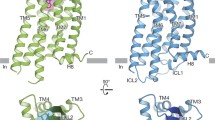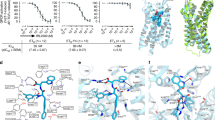Abstract
ENDOTHELIN-1 was initially identified as a 21-residue potent vasoconstrictor peptide produced by vascular endothelial cells, but was subsequently found to have many effects on both vascular and non-vascular tissues1,2. The discovery of three isopeptides of the endothelin family3, ET-1, ET-2 and ET-3, each possessing a diverse set of pharmacological activities of different potency, suggested the existence of several different endothelin receptor subtypes3–7. Endothelins may elicit biological responses by various signal-transduction mechanisms, including the G protein-coupled activation of phospholipase C and the activation of voltage-dependent Ca2+ channels8–10. Thus, different subtypes of the endothelin receptor may use different signal-transduction mechanisms. Here we report the cloning of a complementary DNA encoding one subtype belonging to the superf amily of G protein-coupled receptors. COS-7 cells transfected with the cDNA express specific and high-affinity binding sites for endothelins, responding to binding by the production of inositol phosphates and a transient increase in the concentration of intracellular free Ca2+. The three endothelin isopeptides are roughly equipotent in displacing 125I-labelled ET-1 binding and causing Ca2+ mobilization. A messenger RNA corresponding to the cDNA is detected in many rat tissues including the brain, kidney and lung but not in vascular smooth muscle cells. These results indicate that this cDNA encodes a 'nonselective' subtype of the receptor which is different from the vascular smooth muscle receptor.
Similar content being viewed by others
References
Yanagisawa, M. et al. Nature 332, 411–415 (1988).
Yanagisawa, M. & Masaki, T. Trends pharmacol. Sci. 10, 374–378 (1989).
Inoue, A. et al. proc. natn. Acad. Sci. U.S.A. 86, 2863–2867 (1989).
Masuda, Y. et al. FEBS Lett. 257, 208–210 (1989).
Kloog, Y., Bousso, M. D., Bdolah, A. & Sokolovski, M. FEBS Lett. 253, 199–202 (1989).
Maggi, C. A. et al. Eur. J. Pharmac. 176, 1–9 (1990).
Warner, T. D., de Nucci, G. & Vane, J. R. Eur. J. Pharmac. 159, 325–326 (1989).
Kasuya, Y. et al. Biochem. blophys. Res. Commun. 61, 1049–1055 (1989).
Takuwa, Y. et al. J. clin. Invest. 85, 653–658 (1990).
Resink, T. J., Scott-Burden, T. & Buhler, F. R. Eur. J. Biochem. 189, 415–421 (1990).
Seed, B. Nature 329, 840–842 (1987).
Koseki, C., Imai, M., Hirata, Y., Yanagisawa, M. & Masaki, T. Am. J. Physiol. 256, R858–R866 (1989).
MacCumber, M. W., Ross, C. A., Glaser, B. M. & Snyder, S. H. Proc. natn. Acad. Sci. U.S.A. 86, 7285–7289 (1989).
Shaw, G. & Kamen, R. Cell 46, 659–667 (1986).
von Heijine, G. Nucleic Acids Res. 14, 4683–4690 (1989).
Schvartz, I., Ittoop, O. & Hazum, E. Endocrinology 126, 3218–3222 (1990).
Strader, C. D., Irving, S. S. & Richard, A. F. FASEB J. 3, 1825–1832 (1989).
Permentier, M. et al. Science 246, 1620–1622 (1989).
McFarland, C. et al. Science 245, 494–499 (1989).
Kobilka, B. et al. Science 240, 1310–1316 (1988).
Fukuda, N. et al. Biochem. biophys. Res. Commun. 167, 739–745 (1990).
Hirata, Y. et al. Biomed. Res. 11, 195–198 (1990).
Takuwa, Y., Masaki, T. & Yamashita, K. Biochem. biophys. Res. Commun. 170, 998–1005 (1990).
Bousso, M. D. et al. Biochem. biophys. Res. Commun. 162, 952–957 (1989).
Ohnishi-Suzaki, A. et al. Biochem. biophys. Res. Commun. 166, 608–614 (1990).
Cozza, E. N., Gomez-Sanchez, C. E., Foecking, M. F. & Chiou, S. J. clin. Invest. 84, 1032–1035 (1989).
Marsault, R., Vigne, P., Breittmayer, J. P. & Frelin, C. J. J. Neurochem. 54, 2142–2144 (1990).
Martin, E. R., Brenner, B. M. & Ballermann, B. J. biol. Chem. 265, 14044–14049 (1990).
Sambrook, J., Fritsch, E. F. & Maniatis, T. Molecular Cloning: A Laboratory Manual (Cold Spring Harbor Laboratory, New York, 1989).
Kozak, M. Nucleic Acids Res. 12, 857–874 (1984).
Author information
Authors and Affiliations
Rights and permissions
About this article
Cite this article
Sakurai, T., Yanagisawa, M., Takuwat, Y. et al. Cloning of a cDNA encoding a non-isopeptide-selective subtype of the endothelin receptor. Nature 348, 732–735 (1990). https://doi.org/10.1038/348732a0
Received:
Accepted:
Issue Date:
DOI: https://doi.org/10.1038/348732a0
- Springer Nature Limited
This article is cited by
-
Targeting the Endothelin-1 pathway to reduce invasion and chemoresistance in gallbladder cancer cells
Cancer Cell International (2023)
-
Fly casting with ligand sliding and orientational selection supporting complex formation of a GPCR and a middle sized flexible molecule
Scientific Reports (2022)
-
Relationship between endothelin and nitric oxide pathways in the onset and maintenance of hypertension in children and adolescents
Pediatric Nephrology (2022)
-
Renal biomarkers of acute kidney injury in response to increasing intermittent hypoxia episodes in the neonatal rat
BMC Nephrology (2021)
-
Role of central endothelin-1 in hyperalgesia, anhedonia, and hypolocomotion induced by endotoxin in male rats
Experimental Brain Research (2021)





